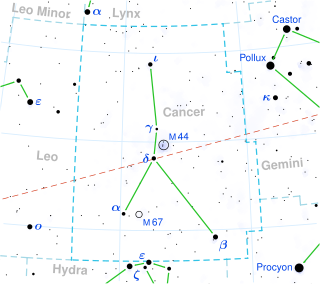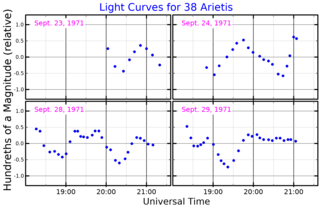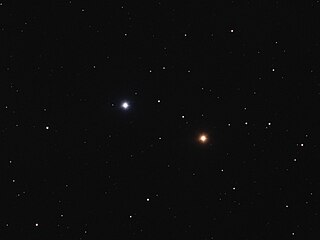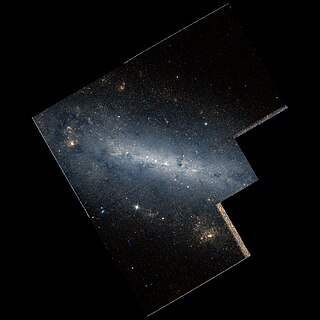
Acubens, Bayer designation Alpha Cancri, is a star system in the constellation of Cancer.

Kappa Arietis, Latinized from κ Arietis, is the Bayer designation for a binary star in the northern constellation of Aries. The combined apparent visual magnitude of the pair is 5.02, making the system bright enough for it to be dimly visible to the naked eye as a white-hued point of light. It is located approximately 181 light-years from the Sun based on parallax, and is drifting further away with a radial velocity of +11.5 km/s.

Eta Arietis, Latinized from η Arietis, is the Bayer designation for a star in the northern constellation of Aries. It is dimly visible to the naked eye with an apparent visual magnitude of 5.231. With an annual parallax shift of 33.34 mas, the distance to this star is approximately 97.8 light-years. It is drifting further away with a radial velocity of +4.5 km/s.

Theta Arietis, Latinised from θ Arietis, is the Bayer designation for a binary star system in the northern constellation of Aries. It is faintly visible to the naked eye with an apparent visual magnitude of 5.58. With an annual parallax shift of 7.61 mas, the distance to this star is an estimated 429 light-years with a 10-light-year margin of error. It is drifting further away with a radial velocity of +6 km/s.

106 Aquarii, abbreviated 106 Aqr, is a single star in the equatorial constellation of Aquarius. 106 Aquarii is the Flamsteed designation, and it also bears the Bayer designation i1 Aquarii. It has an apparent visual magnitude of +5.2, making it bright enough to be viewed from the suburbs according to the Bortle Dark-Sky Scale. An annual parallax shift of 8.61 milliarcseconds yields an estimated distance of around 380 light-years from Earth.
107 Aquarii is a double star in the equatorial constellation of Aquarius. 107 Aquarii is the Flamsteed designation, although it also bears the Bayer designation i2 Aquarii. The pair have an angular separation of 6.787 arcseconds. They have a combined apparent visual magnitude of +5.305, with individual magnitudes of 5.72 and 6.72. The annual parallax shift measured for the two components is 16.1 mas and 20.0 mas respectively, although with significant statistical margins of error and flags for potential unreliability of both values. This indicates the system may be at a distance of 160–200 light-years from Earth.

38 Arietis is a variable star in the northern constellation of Aries. 38 Arietis is the Flamsteed designation. It was once designated 88 Ceti, forming part of the neighboring constellation of Cetus. With an apparent visual magnitude of +5.18, it is bright enough to be viewed with the naked eye. The measured annual parallax shift of 27.52 mas is equivalent to a distance of approximately 119 light-years from Earth.
33 Arietis is a binary star in the northern constellation of Aries. 33 Arietis is the Flamsteed designation. The combined apparent magnitude of 5.33 is bright enough to be seen with the naked eye. Based upon an annual parallax shift of 14.09 mas, the distance to this system is approximately 231 light-years.

26 Arietis is a variable star in the northern constellation of Aries. 26 Arietis is the Flamsteed designation; it also bears the variable star designation UU Arietis. The apparent visual magnitude of this star is 6.14, which, according to the Bortle Dark-Sky Scale, is within the naked eye visibility limit in dark rural skies. The annual parallax shift of 13.78 mas is equivalent to a distance of approximately 215 light-years from Earth. The star is receding from the Earth with a heliocentric radial velocity of +15 km/s.

Nu1 Boötis (ν1 Boötis) is an orange-hued star in the northern constellation of Boötes. It has an apparent visual magnitude of +5.02, which indicates the star is faintly visible to the naked eye. Based upon an annual parallax shift of 3.89 mas as seen from Earth, it is located roughly 840 light years distant from the Sun. At that distance, the visual magnitude of the star is diminished by an extinction of 0.13 due to interstellar dust.

Omega1 Aquarii, Latinized from ω1 Aquarii, is the Bayer designation for a single star in the equatorial constellation of Aquarius. With an apparent visual magnitude of 4.96, this star is faintly visible to the naked eye from the suburbs. The distance to this star can be estimated from the parallax as approximately 138 light-years.
The Centre de Données astronomiques de Strasbourg is a data centre which collects and distributes astronomical information . It was established in 1972 under the name Centre de Données Stellaires by the National Institute of Astronomy and Geophysics (INAG). The on-line services currently provided by the CDS include:
The VizieR Catalogue Service is an astronomical catalog service provided by Centre de données astronomiques de Strasbourg. The origin of the service dates back to 1993, when it was founded by the European Space Agency as the European Space Information System (ESIS) Catalogue Browser. Initially intended to serve the space science community, the ESIS project pre-dates the World Wide Web as a network database allowing uniform to a heterogeneous set of catalogues and data.
26 Vulpeculae is a close binary star system in the northern constellation of Vulpecula, around 644 light years away from the Sun. It is a challenge to view with the naked eye, having an apparent visual magnitude of 6.40. The star is moving closer to the Earth with a heliocentric radial velocity of −63 km/s, and is expected to come within 225 light-years in around 2.6 million years.
39 Leonis is the Flamsteed designation for a star in the zodiac constellation of Leo. It has an apparent visual magnitude of 5.90, so, according to the Bortle scale, it is faintly visible from suburban skies at night. Parallax measurements show an annual parallax shift of 0.0449″, which is equivalent to a distance of around 72.6 ly (22.3 pc) from the Sun.

9 Ceti is a star in the equatorial constellation of Cetus. It has the variable star designation BE Ceti, while 9 Ceti is the Flamsteed designation. It has an apparent visual magnitude of 6.4, which is below the limit that can be seen with the naked eye by a typical observer. Based upon parallax measurements, this star is 69.6 light years away from the Sun.

NGC 672 is a spiral galaxy in the northern constellation of Triangulum, positioned around 2° to the southwest of the star Alpha Trianguli. The original object designated NGC 672 was discovered by the German-born astronomer William Herschel on 26 October 1786, but this was later cataloged as NGC 614. The object now identified as NGC 672 was discovered by John Herschel on 11 November 1827.

NGC 127 is a lenticular galaxy that was discovered on November 4, 1850, by Bindon Stoney, the same day he discovered NGC 126 and NGC 130. NGC 127 is a gas-rich, star-forming galaxy showing emission lines. It is an interacting companion to the peculiar, edge-on galaxy NGC 128, and the pair are connected by a bridge of material. The south-east part of NGC 127 is asymmetrical in the direction of NGC 128. It may have recently passed the more massive NGC 128, from which an infall of gas is flowing onto NGC 127.

KX Andromedae is a spectroscopic binary star in the constellation Andromeda. Its apparent visual magnitude varies between 6.88 and 7.28.











